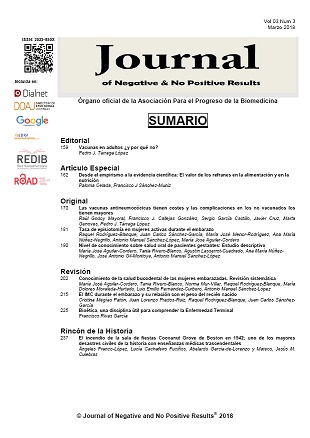The Boston Cocoanut Grove Nightclub fire in 1942: one of the greatest civilian disasters with key medical lessons
DOI:
https://doi.org/10.19230/jonnpr.2047Keywords:
Civilian catastrophe, Burns, Inhalation injuryAbstract
The Cocoanut Grove Nightclub fire in 1942 in Boston, killing 492 people and sending hundreds more to area hospitals was, probably, one of the largest civilian disasters in American history. The disaster resulted in a number of important advances in burn treatment, including the first comprehensive descriptions of inhalation injury, improvement in topical treatment of burn wounds, resuscitation of shock and understanding of the metabolic response to surgery. The fire also stimulated organization of burn care facilities, public safety legislation, and burn prevention. Forty years later a similar tragedy occurred in Madrid, Spain, when the discotheque Alcala 20 was burnt. Conditions of inadequacy and negligence of the place and patrons doubling the authorized number originated a disaster with 82 killed.
Downloads
References
Aub JC, Pittman H, Brues AM. The pulmonary complications: a clinical description. Ann Surg 1943; 117(6): 834-840
Culebras JM. Francis Moore, cirujano, maestro y lider. Editorial Sever Cuesta, Valladolid 2009. https://web.archive.org/web/20130903163638/http://www.nutricionhospitalaria.com/LIBRO_FRANCIS_MOORE.pdf
Clowes GHA, Lund CC, Levenson SM. The surface treatment of burns: a comparison of results of tannic acid, silver nitrate, triple dye, and vaseline or boric ointment as surface treatments in 150 cases. Ann Surg 1943; 118:761-79
Schatzki R. Management of the Cocoanut Grove Burns at the Massachusetts General Hospital: Roentgenologic report of the pulmonary lesions. Ann Surg 1943; 117: 841
Reilly WA. Report concerning the Cocoanut Grove Fire, November 28, 1942. Boston: City of Boston Printing Department, 1943: 1-64
Finland M, Davidson CS, Levenson SM. Effects of plasma and fluid on pulmonary complications in burned patients: study of the effects in victims of the Cocoanut Grove fire. Arch Intern Med 1946; 77: 477-90.
Cope O, Moore FD, The redistribution of body water and the fluid therapy of the burned patient. Ann Surg 1947; 126: 1010-45.
Foster K, Holmes JH. Inhalation Injury: State of Science 2016. J Burn Care Res 2017; 38: 137-41
Tredget EE, Shankowsky HA, Taerum TV, Moysa GL, Alton JDM. The role of inhalation injury in burn trauma. A Canadian experience. Ann Surg 1990; 212: 720–7
Enkhbaatar P, Traber DL. Pathophysiology of acute lung injury in combined burn and smoke inhalation injury. Clin Sci (Lond) 2004; 107: 137–43
Barrow RE, Spies M, Barrow LN, Herndon DN. Influence of demographics and inhalation injury on burn mortality in children. Burns 2004; 30: 72–7
Palmieri TL. Inhalation injury: research progress and needs. J Burn Care Res 2007; 28: 549–54
Putman CE, Loke J, Matthay RA, Ravin CE. Radiographic manifestations of acute smoke inhalation. AJR Am J Roentgenol 1977; 129: 865-70
Wittram C, Kenny JB. The admission chest radiograph after acute inhalation injury and burns. Br J Radiol 1994; 67: 751–4
Brusselaers N, Hoste EA, Monstrey S, Colpaert KE, De Waele JJ, Vandewoude KH, Blot SI. Outcome and changes over time in survival following severe burns from 1985 to 2004. Intensive Care Med 2005; 31: 1648-53
Mackie DP, Spoelder EJ, Paauw RJ, Knape P, Boer C. Mechanical ventilation and fluid retention in burn patients. J Trauma 2009; 67: 1233–8
Harrington DT. Complicate burn resucitation. Critical Care Clin. 2016; 32: 577-86
Sheridan RL. Fire-related inhalation injury. N Engl J Med 2016; 375: 464-9
Incendio de la discoteca Alcalá 20. Wikipedia. https://es.wikipedia.org/wiki/Incendio_de_la_discoteca_Alcal%C3%A1_2 0
Philips AW, Cope O. Burn Therapy. II The revelation of respiratory tract as a principal killer of the burned patient. Annals of Surgery 1962; 155 (1):1-19
Cope O. Management of the Cocoanut Grove Burns al the Massachusetts general Hospital. Ann Surg 1943; 117 (6): 801-965
Cope O. Care of the victims of the Cocoanut Grove fire at the Massachusetts General Hospital. N Engl J Med 1943; 229:138-147
Saffle JR.The 1942 Fire at Boston's Cocoanut Grove Nightclub. Am J Surg 1993; 166:581-591
Moore FD. The respiratory tract injury of burns: lessons from the past. In: Haponik EF, Munster AM, eds. Respiratory injury, smoke inhalation, and burns. New York: McGraw-Hill, 1990; 1-16.
Moore FD. A miracle & a privilege. Recounting a half century of Surgical Advance. ISBN 0-309-05188-6. Joseph Henry Press, National Academy of Sciences, Washington DC 1995
Cachafeiro-Fuciños L. La influencia del síndrome de inhalación en la evolución y el pronóstico del paciente quemado crítico. Tesis Doctoral. Universidad Autónoma de Madrid. Junio 2017
Published
Issue
Section
License
All accepted originals remain the property of JONNPR. In the event of publication, the authors exclusively transfer their rights of reproduction, distribution, translation and public communication (by any sound, audiovisual or electronic medium or format) of their work. To do so, the authors shall sign a letter transferring these rights when sending the paper via the online manuscript management system.
The articles published in the journal are freely used under the terms of the Creative Commons BY NC SA license, therefore.
You are free to:
Share — copy and redistribute the material in any medium or format
Adapt — remix, transform, and build upon the material
The licensor cannot revoke these freedoms as long as you follow the license terms.
Under the following terms:
Attribution — You must give appropriate credit, provide a link to the license, and indicate if changes were made. You may do so in any reasonable manner, but not in any way that suggests the licensor endorses you or your use.
NonCommercial — You may not use the material for commercial purposes.
ShareAlike — If you remix, transform, or build upon the material, you must distribute your contributions under the same license as the original.
No additional restrictions — You may not apply legal terms or technological measures that legally restrict others from doing anything the license permits.

This work is licensed under a Creative Commons Attribution-NonCommercial-ShareAlike 4.0 International License

























